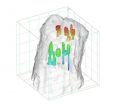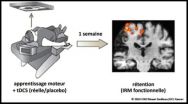Paying attention makes touch-sensing brain cells fire rapidly and in sync
A step toward cracking the code of how brains work
2014-12-09
(Press-News.org) Whether we're paying attention to something we see can be discerned by monitoring the firings of specific groups of brain cells. Now, new work from Johns Hopkins shows that the same holds true for the sense of touch. The study brings researchers closer to understanding how animals' thoughts and feelings affect their perception of external stimuli.
The results were published Nov. 25 in the journal PLoS Biology.
"There is so much information available in the world that we cannot process it all," says Ernst Niebur, Ph.D., a professor of neuroscience in the Johns Hopkins University School of Medicine. "Many researchers believe the brain copes with this by immediately throwing away most of what we take in -- that's called selective attention. But we need to be certain that what is thrown away is really the irrelevant part. We investigated how our neurons do that."
Niebur, a computational biologist, worked with Steven Hsiao, Ph.D., a professor of neuroscience in Johns Hopkins' Zanvyl Krieger Mind/Brain Institute, who died in June, on the study. Hsiao's assistant research scientist, Manuel Gomez-Ramirez, Ph.D., trained three rhesus monkeys to pay attention to either the orientation (vertical or horizontal) or the vibration rate (fast or slow) of a pencil-shaped object using their sense of touch. The monkeys learned to move their gaze to a location on a monitor screen corresponding to the right answer and were rewarded with drops of juice or water.
Gomez-Ramirez then monitored the activity of groups of neurons and figure out which were in charge of perceiving which property. When the monkeys were paying attention to the object's orientation, he found, the neurons for that property fired more rapidly, and more synchronously, than did neurons for the vibration rate. That much was consistent with previous studies on selective attention in vision.
In addition, the research team found, the firing rate of the neurons for the property, and how much they synced up, predicted how well the monkey did on the task -- whether it at to the correct location on the monitor. But synchronization was more important to performance than was firing rate.
The results are a step toward "cracking the neural code," he says, an ambitious goal for which his research group continues to strive. "We're looking for the neural code of internal thought processes," he says. "It's a very fundamental question."
INFORMATION:
Other authors on the paper are Natalie K. Trzcinski of The Johns Hopkins University and Stefan Mihalas, formerly of The Johns Hopkins University and now of the Allen Institute for Brain Science.
The study was funded by the National Institute of Neurological Disorders and Stroke (grant numbers R01NS34086 and R01NS18787), the National Eye Institute (grant number R01EY016281) and the Office of Naval Research's Multidisciplinary University Research Initiatives Program (grant number N000141010278).
ELSE PRESS RELEASES FROM THIS DATE:
2014-12-09
LIVERMORE, Calif. -- Large-scale storage of low-pressure, gaseous hydrogen in salt caverns and other underground sites for transportation fuel and grid-scale energy applications offers several advantages over above-ground storage, says a recent Sandia National Laboratories study sponsored by the Department of Energy's Fuel Cell Technologies Office.
Geologic storage of hydrogen gas could make it possible to produce and distribute large quantities of hydrogen fuel for the growing fuel cell electric vehicle market, the researchers concluded.
Geologic storage solutions ...
2014-12-09
Neuro-rehabilitation (physical therapy, occupational therapy, etc.) helps hemaparetic stroke patients confronted with loss of motor skills on one side of their body, to recover some of their motor functions after a cerebrovascular accident. One of the most promising tracks in neuro-rehabilitation consists in amplifying the motor learning ability after a stroke, in other words how to learn (again) how to make movements with the parts of the human body impacted after a stroke.
Pilot studies have shown at this matter that tDCS (transcranial direct current stimulation) - ...
2014-12-09
Nidelric pugio fossil dates to half a billion years ago and teaches us about the diversity of life in Earth's ancient seas
In life the animal was a 'balloon' shape and was covered in spines, but the squashed fossil resembles a bird's nest
Named in honour of Professor Richard Aldridge from the University of Leicester
A rare 520 million year old fossil shaped like a 'squashed bird's nest' that will help to shed new light on life within Earth's ancient seas has been discovered in China by an international research team - and will honour the memory of a University of ...
2014-12-09
Montreal, Canada, November x, 2014 - Angiochem, a clinical stage biotechnology company creating and developing drugs that cross the blood-brain barrier, today announced the publication in Molecular Cancer Therapeutics demonstrating that ANG4043, a peptide-monoclonal antibody (mAb) conjugate, entered the brain at therapeutic concentrations, resulting in significantly prolonged survival in mice. The antibody is directed against HER2, which is the protein targeted by Herceptin®. Because the mAb is conjugated to Angiopep-2, it is recognized by the LRP1 receptor and takes ...
2014-12-09
Phoenix, AZ (December 9th, 2014) - Healthy, elderly research participants who report being more sleepy and less rested have higher levels of amyloid deposition in regions of the brain that are affected in Alzheimer's disease, according to a report presented today at the American College of Neuropsychopharmacology annual meeting in Phoenix (Arizona). If sleep disturbance is a cause of amyloid accumulation, it may be an early target for intervention to prevent the progression of cognitive deficits in late life.
Numerous studies have shown the importance of sleep and the ...
2014-12-09
Phoenix, AZ (December 9th, 2014) - Abnormalities in the prefrontal cortex and related brain areas are observed in adolescents who have attempted suicide, according to a report today at the American College of Neuropsychopharmacology annual meeting in Phoenix Arizona. The study suggests that deficits in frontal systems may be associated with risk for suicide attempts in youths with mood disorders.
Most suicide attempts occur in the context of mood disorders, including bipolar disorder and major depressive disorder. Bipolar disorder has a prevalence of 3-4% in the U.S. population, ...
2014-12-09
A multicenter phase 1 trial of the immune checkpoint blocker ipilimumab found clinical benefit in nearly half of blood cancer patients who had relapsed following allogeneic stem cell transplantation, according to investigators from Dana-Farber Cancer Institute, who developed and lead the study.
The study reported at the American Society of Hematology annual meeting is the first in which ipilimumab was given in multiple doses over an extended time period, the researchers said.
At a median follow-up time of six months, "We have seen less toxicity than expected and a strong ...
2014-12-09
A study that investigated the potential of the compound PRM-151 (PRM) for reducing progressive bone marrow fibrosis (scarring) in patients with advanced myelofibrosis has shown initial positive results. Myelofibrosis is a life-threatening bone marrow cancer.
The study, led by Srdan Verstovsek, M.D., Ph.D., professor of leukemia at The University of Texas MD Anderson Cancer Center, showed the compound was well tolerated in observing 27 patients. Verstovsek's research results were presented today at the 56th Annual Meeting of the American Society of Hematology (ASH) annual ...
2014-12-09
Aiming to empower planners and policy-makers to achieve better health for billions of people living in fast-growing urban areas, world health, environmental, behavioural and social science experts today launched a major new interdisciplinary scientific collaboration.
Programme goals:
Empowering planners and policy-makers with better science to create healthy urban environments and improve wellbeing;
Identify and manage unintended health consequences of urban policy;
Understand connections between cities and planetary change
Leading the consortium of science ...
2014-12-09
Opposing views on the potential impact of electronic cigarettes on public health are published in the open access journal BMC Medicine. The commentaries, by two experts, differ in their views on the topic but are united in their call for a rational discussion based on evidence.
The authors examine the WHO's recommendations earlier this year. One recommendation was that smokers should not use e-cigarettes and has now been withdrawn, and the other is that policymakers should implement their strict regulation, which is still in force.
In one of the commentaries, Peter ...
LAST 30 PRESS RELEASES:
[Press-News.org] Paying attention makes touch-sensing brain cells fire rapidly and in sync
A step toward cracking the code of how brains work



